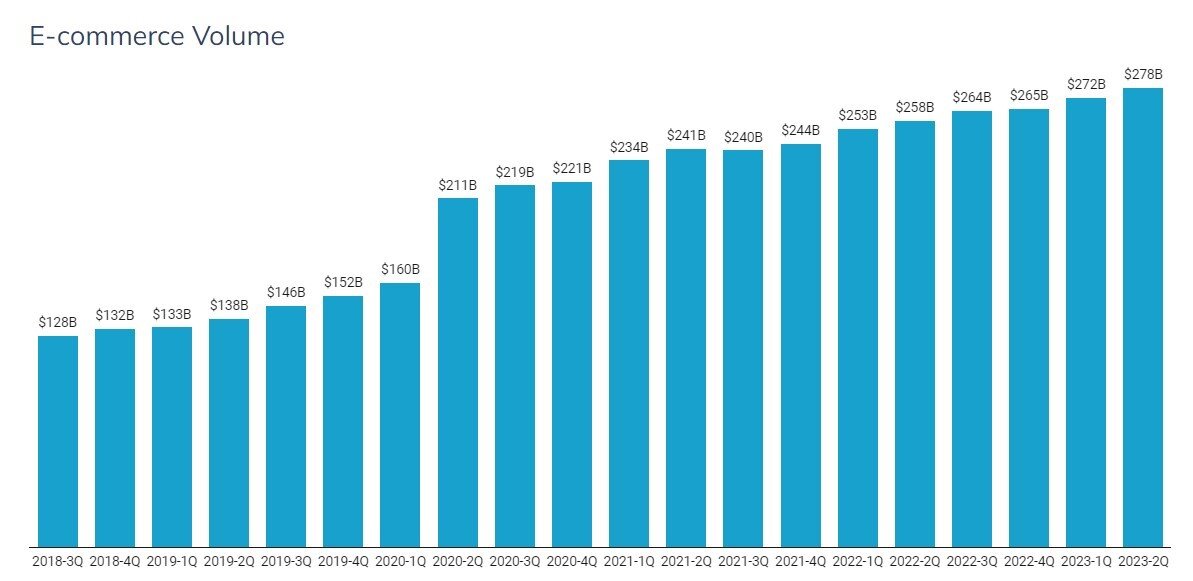Commercial Real Estate News

Industrial Market Rebalances as E-commerce Growth Normalizes in U.S.
Commercial News » Dallas Edition | By Michael Gerrity | October 30, 2023 8:35 AM ET
The e-commerce boom that began in the early days of the pandemic helped send demand for industrial real estate to never-before-seen heights, but as growth has normalized, a rebalancing has taken shape, according to CommercialEdge's latest 2023 U.S. industrial market report.
E-commerce sales volume exploded in 2020, a shock that reshaped retail as we knew it. While growth cooled in subsequent quarters, the gains made during the pandemic are now entrenched.
E-commerce sales volume has increased by 74% since the first quarter of 2021, although almost half of those gains were made in the initial spike in the second quarter of 2021. During the second quarter of this year, there was a total of $277.6 billion in e-commerce sales, according to the Census Bureau, an increase of 2.1% over the first quarter and 7.5% year-over-year.
While on the surface, these numbers look robust, there are caveats. From 2010 (when the Census Bureau began providing the data series) to the first quarter of 2020, e-commerce sales grew at an average rate of 3.6% per quarter. Following the initial COVID-induced spike, that average is just 2.2%. It is also important to note that these numbers are not inflation-adjusted, and increasing prices account for a portion of the growth. Still, e-commerce's share of core retail sales (excluding motor vehicles, their parts and gasoline) has increased from 14.2% in the first quarter of 2020 to 18.4% in the third quarter.
CommercialEdge Senior Manager Peter Kolaczynski says, "Naturally, construction is going to slow compared to levels from the COVID explosion, but we see e-commerce as a consistent driver for sustainable and normalized demand through the rest of the decade."
Even as online sales growth has normalized, it continues to drive significant demand for industrial space because e-commerce operations require much more logistics space than traditional brick-and-mortar. Prologis estimates the additional space necessary for online sales to be three times higher due to "piece picking, product variety, direct-to-consumer shipping and the need to process returns."
While Amazon made waves when it paused on canceled large fulfillment centers last year, traditional big box retailers are still in the process of adding those spaces. Wal-Mart recently opened a 1.5 million automated fulfillment center, the second of four such announced projects that will allow the company to reach 95% of the population with one- or two-day shipping.
CommercialEdge expects e-commerce to remain a considerable driver of growth in the industrial sector for the foreseeable future. Both multi-million-square-foot facilities and small-scale in-fill centers for last-mile delivery will be necessary for retailers to provide customers with a quick and efficient omnichannel experience. Many existing retailers will look to consolidate brick-and-mortar operations and streamline logistics networks, further fueling demand for space, the U.S. industrial property outlook predicts.
Sign Up Free | The WPJ Weekly Newsletter
Relevant real estate news.
Actionable market intelligence.
Right to your inbox every week.
Real Estate Listings Showcase
Related News Stories
Commercial Real Estate Headlines
- U.S. Commercial Mortgage Delinquencies Rise in Q2, CMBS Loans Lead the Surge
- Tokenization-Focused Real Estate Investment Bank Announced
- Commercial Cap Rates Edge Lower in U.S., Hinting at Market Turn
- WPV Targets New $6 Trillion Digital Real Estate Tokenization Opportunity
- $1 Trillion in Data Center Development Underway Through 2030
- WORLD PROPERTY VENTURES: The 'Anti-VC' of Real Estate Plans Major Capital Raise
- Multifamily Sector Enjoys Record Absorption in U.S. as Supply Slows, Vacancies Drop
- Employee Back-to-Office Attendance Surges in U.S.
- Phnom Penh Commercial Property Sectors Face Crosswinds in 2025
- World Property Bank Announced to Capitalize on Coming Trillion-Dollar Tokenization Boom
- REAL ESTATE PREDICTIONS: Decentralized Events Contract Exchange in Development
- U.S. Architecture Billings Improve Slightly in May
- Tokyo Office Demand Spills into Non-Core Wards in 2025
- AI Hyperscalers Drive Record Data Center Leasing in Early 2025
- Commercial, Multifamily Mortgage Debt in U.S. Hits Record $4.81 Trillion in Early 2025
- U.S. Multifamily Market Rebounds in Early 2025
- U.S. Office Market Experiences Historic Conversion Shift
- New York City Enters New Era of Office-to-Residential Conversions
- World Property Ventures Plans New Capital Raise
- U.S. Commercial Real Estate Lending Rebounds Sharply in Early 2025
- U.S. Multifamily Housing Confidence Declines in Early 2025
- Asia Pacific Commercial Investment Holds Steady in Early 2025
- Carnival Plans New Miami Headquarters Spanning Over 600,000 Square Feet
- Hong Kong Property Investors Take a Wait-and-See Approach Due to U.S. Tariffs
- U.S. Multifamily Buyer and Seller Sentiment Improves in Early 2025
- One Trillion Dollars of America's Commercial Property Loans Mature in 2025
- U.S. West Coast Dominates Self Storage Demand
- Phoenix, Orange County and Inland Empire Emerge as Leading U.S. Industrial Markets
- U.S. Mega Distribution Centers Leasing Activity Grew in 2024
- U.S. Commercial Borrowing to Increase to $583 Billion in 2025, Up 16 Percent Annually
- Demand for U.S. Life Sciences Space Spikes 28 Percent Annually in Late 2024
- Multifamily Property Sector in America Rebounding
- Asia Pacific Commercial Property Investment Spikes 23 Percent in 2024
- U.S. Commercial Property Market Primed for Growth in 2025
- Architecture Industry Sees Mixed Signals as 2025 Approaches
- Global Data Center Demand Spikes in 2025
- 2025 Prediction: U.S. Commercial Investment Recovery Expected to Gain Traction
- Holiday Retail Sales for 2024 to Hit Record $1 Trillion
- Tech, AI Industries Drive Largest Share of Office Leasing Activity in U.S.
- Commercial Real Estate Lending in U.S. Enjoys Strong Growth in Q3








